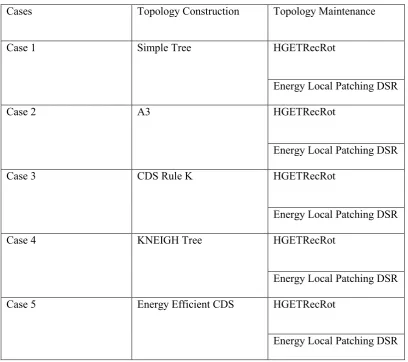i
A COMPARATIVE STUDY OF TOPOLOGY CONTROL ALGORITHM IN WIRELESS SENSOR NETWORK
MUHAMAD IZZAT AFIFI BIN ROSLAN
This report is submitted in partial fulfillment of requirements for the Bachelor of Electronic Engineering (Telecommunication Electronics)
Faculty of Electronic and Computer Engineering
Universiti Teknikal Malaysia Melaka
ii
UNIVERSTI TEKNIKAL MALAYSIA MELAKA
FAKULTI KEJURUTERAAN ELEKTRONIK DAN KEJURUTERAAN KOMPUTER
BORANG PENGESAHAN STATUS LAPORAN
PROJEK SARJANA MUDA II
Tajuk Projek : ………
Sesi Pengajian :
Saya ………..
(HURUF BESAR)
mengaku membenarkan Laporan Projek Sarjana Muda ini disimpan di Perpustakaan dengan syarat-syarat kegunaan seperti berikut:
1. Laporan adalah hakmilik Universiti Teknikal Malaysia Melaka.
2. Perpustakaan dibenarkan membuat salinan untuk tujuan pengajian sahaja.
3. Perpustakaan dibenarkan membuat salinan laporan ini sebagai bahan pertukaran antara institusi
pengajian tinggi.
4. Sila tandakan ( √ ) :
SULIT*
*(Mengandungi maklumat yang berdarjah keselamatan atau kepentingan Malaysia seperti yang termaktub di dalam AKTA RAHSIA RASMI 1972)
TERHAD** **(Mengandungi maklumat terhad yang telah ditentukan oleh organisasi/badan di mana penyelidikan dijalankan)
TIDAK TERHAD
Disahkan oleh:
__________________________ ___________________________________
(TANDATANGAN PENULIS) (COP DAN TANDATANGAN PENYELIA)
iii
“I acknowledge that this report is entirely my work except summary and passage I have quoted the source”
Signature : ………
Author Name : MUHAMAD IZZAT AFIFI BIN ROSLAN
iv
“I acknowledge that I have read this report and in my opinion this thesis is sufficient in terms of scope and quality for the award of Bachelor of Electronic Engineering (Telecommunication
Electronics)”
Signature : ………
v
vi
ACKNOWLEDGEMENT
First and foremost, I am grateful and thanks to Allah S.W.T for blessing me with good health in completing this project. I also would like to express my greatest gratitude to my most dedicated and supportive supervisor, Puan Zahariah binti Manap for providing her insightful knowledge and valuable assistance throughout the completion and successfully of this project under her guidance.
A special note of appreciation is extended to my parents, for their unfailing encouragement and financial support that they have given to me for over the years. Their supports and encouragement is one of the main causes of the success I gain.
Thanks also to all my friends for their guidance and knowledge they provide to me. My thanks also go to all who support me directly and indirectly in completing this project.
vii
ABSTRACT
viii
ABSTRAK
ix
LIST OF TABLE
NO
TITLE
PAGE
1.1
TC and TM cases combination
4
2.1
Description of protocols used in the project
10
2.2
Nodes receive Hello Message from node A
12
3.1
Simulation parameter used in all cases 26
3.2
Cases and their respective combination of Topology
Maintenance and Topology Construction 27
x
LIST OF FIGURE
NO
TITLE
PAGE
1.1(a)
Original Topology
3
1.1(b)
Reduced A3 Topology
3
2.1
Basic block diagram of a wireless sensor node
7
2.2(a)
Step by step from original topology to first phase and final
topology by CDS Rule K 15
2.2(b)
Step by step from original topology to first phase and final
topology by CDS Rule K 15
2.2(c)
Step by step from original topology to first phase and final
topology by CDS Rule K 15
2.3(a)
Step by step of EECDS algorithm behavior in creating topology 17
2.3(b)
Step by step of EECDS algorithm behavior in creating topology 17
2.3(c)
Step by step of EECDS algorithm behavior in creating topology 17
xi
NO
TITLE
PAGE
3.1
Flowchart of project 25
3.2
Node Deployment 29
3.3
Topology Construction and Topology Maintenance tab 30
3.4
Saving the simulation report 31
3.5
Tabulation of data for various TC with HGETRecRot 31
3.6
Graph plotted for network lifetime for various TC with
Energy Local Patching DSR TM 32
4.1
Comparison of energy spent ratio for various TC-TM
combinations 35
4.2
Comparison of final nodes status for various TC-TM
combinations 35
4.4(a)
Example of A3 Topology Construction and Energy
Local Patching DSR Topology Maintenance 37
4.4(b)
Example of A3 Topology Construction and Energy
Local Patching DSR Topology Maintenance 37
4.5(a)
Number of messages received by sink and number of
messages sent by other nodes for various TC and
HGETRecRot TM 38
4.5(b)
Number of messages received by sink and number of
messages sent by other nodes for various TC and Energy
Local Patching DSR
38xii
NO
TITLE
PAGE
4.6(b)
Number of nodes alive and nodes reachable from sink for
Simple Tree and HGETRecRot 40
4.7(a)
Number of nodes alive and nodes reachable from sink for
A3 and Energy Local Patching DSR 41
4.7(b)
Number of nodes alive and nodes reachable from sink for
Simple Tree and HGETRecRot 41
4.8(a)
Number of nodes alive and nodes reachable from sink for
CDS Rule K and Energy Local Patching DSR 42
4.8(b)
Number of nodes alive and nodes reachable from sink for
CDS Rule K and HGETRecRot 42
4.9(a)
Number of nodes alive and nodes reachable from sink for
KNEIGH Tree and Energy Local Patching DSR 43
4.9(b)
Number of nodes alive and nodes reachable from sink for
KNEIGH Tree and HGETRecRot 43
4.10(a)
Number of nodes alive and nodes reachable from sink for
EECDS and Energy Local Patching DSR 44
4.10(b)
Number of nodes alive and nodes reachable from sink for
EECDS and HGETRecRot 44
4.11(a)
Number of nodes alive for various TC with HGETRecRot 46
4.11(b)
Number of nodes alive for various TC with Energy Local
xiii
LIST OF APPENDIX
NO OF
TITLE
PAGE
APPENDIX
xiv
TABLE OF CONTENT
TITLE Page
PROJECT TITLE
i
PSM STATUS VERIFICATION FORM
ii
DECLARATION
iii
SUPERVISOR VERIFICATION FORM
iv
DEDICATION
v
ACKNOWLEDGEMENT
vi
ABSTRACT
vii
TABLE LIST
ix
FIGURE LIST
x
APPENDIX LIST
xii
TABLE OF CONTENT
xiv
CHAPTER I: INTRODUCTION
1
1.1 Project Background
1
1.2 Problem Statement
2
1.3 Work Scope
3
xv
CHAPTER II: LITERATURE REVIEW
6
2.1 Wireless Sensor Network
6
2.2 Topology Control
8
2.2.1 Topology Maintenance protocol 10
2.3 Topology Construction(Simple Tree) 11
2.4 Topology Construction(Atarraya 3) 12
2.5 Topology Construction(CDS Rule K) 13
2.6 Topology Construction(KNEIGH Protocol) 15
2.7 Topology Construction
(Energy Efficient Connected Dominating Sets) 16
2.8 Topology Maintenance
(Hybrid Global Topology Recreation and Rotation) 17
2.9 Topology Maintenance (Energy Local Patching DSR) 18
2.10 Related Works 21
2.11 Atarraya Software 22
CHAPTER III: METHODOLOGY
24
3.1 Introduction
26
3.2 Simulation Parameter
28
3.3 Simulation on Atarraya
28
3.3.1 Node Deployment 29
3.3.2 Topology Construction and Topology Maintenance
Parameters 30
3.4 Tabulation of data 30
xvi
CHAPTER IV: RESULT
33
4.1 Energy Consumption
34
4.2 Final Nodes Status
35
4.3 Relationship Between Number of Message Transmission and
Energy Spent 37
4.4 Network Lifetime 39
CHAPTER V: RESULT
48
5.1 Conclusion 48
5.2 Future Recommendation 49
REFERENCES
50
APPENDIX
52
1
CHAPTER 1
INTRODUCTION
1.1 Project Background
Technological advancements have brought a lot change in the modern day life and give new ideas in making life more conveniently to live. The advancement in technology also figures out a new solution to environmental monitoring applications such as in obtaining data from a volcano area which is extremely dangerous to be executed by human being. The deployment of a WSN in the target area can help us study the varying physical quantities under different environmental circumstances over a specified period [1].
2
The sensor node is connected to a battery and efficient consumption of battery resource can increase the network lifetime, this is considered as a challenge while designing WSN algorithm. Improving network lifetime, connectivity, coverage, mobility, security are some of the challenges which are considered when choosing or designing a WSN.
1.2 Problem Statement
Wireless sensors are in general a battery-powered stand-alone devices with limited processing power and communication capabilities. Wireless sensors have limited sources of energy to power their functions. Green technologies are those designed to be more efficient in energy consumption and conservation and/or to utilize greener energy sources than used previously. Sensor network energy utilization and more efficient energy conservation are major areas of concern to ensure proper long term operation of a wireless sensor.
Due to limits on each of the sensor’s communication ranges, sensor network nodes will need to communicate with other nodes to relay information to the user. Different sensor network topologies will exhibit different coverage and energy utilizations. The topology control needs to maintain WSN node connectivity and sensing coverage. Topology Control is an ongoing process that updates the connectivity in a WSN that can be utilized to save energy thereby extending the operational life of the WSN nodes.
3
(a) (b)
Figure 1.1: (a) Original topology, (b) Reduced A3 Topology
1.3 Work Scopes
4
Table 1.1: TC and TM cases combination
Cases Topology Construction Topology Maintenance
Case 1 Simple Tree HGETRecRot
Energy Local Patching DSR
Case 2 A3 HGETRecRot
Energy Local Patching DSR
Case 3 CDS Rule K HGETRecRot
Energy Local Patching DSR
Case 4 KNEIGH Tree HGETRecRot
Energy Local Patching DSR
Case 5 Energy Efficient CDS HGETRecRot
Energy Local Patching DSR
5
1.4 Project Objectives
This project aims to make a performance evaluation of TC protocol in WSN and suggest the most suitable TC-TM combination for a dense WSN. To achieve the aim, three objectives have been listed as follows:
1. To simulate several combinations of TC/TM protocols for WSN by using Atarraya. 2. To investigate the performance of the TC and TM protocols in terms of energy
consumption.
3. To determine the most suitable combination of TC/TM for time-driven WSN applications.
1 .5 Report Structure
6
CHAPTER 2
LITERATURE REVIEW
2.1 Wireless Sensor Network
7
Figure 2.1: Basic block diagram of a wireless sensor node
The core processor generally functions to process the information and control alternate parts in the sensor node. Fundamentally, processor goes about as a brain to the sensor network because of its imperative part. Processor is the primary segment in the sensor network as it relegates the assignments to the sensor nodes and when the sensor node is broke down or harmed, another sensor needs to take its position so that the scope or system integration still in ideal level.
8
The fuctionality of both the receiver and transmitter are incorporated together into a solitary gadget called Transceiver. The node has this functionality fabricated in so that the sensor can send information to the sink node and consequently assembles the control signal from the sink node or from a base station.
Technology advancement in semiconductor industry have come about into reconciliation of effective innovations in a little chip. There are right now a great many sensors which are being made for distinctive applications. Sensors to record temperature, weight and so forth., inside of a transient sensors grew way past the creative ability from detecting quakes, underground marine life, detecting the level of diabetes in the blood inside a human body. All the sensor is picked by sort of utilization to be actualized.
Target area of the sensor is vital while conveying. At the point when the zone of target is known and straightforward, the deployment can be effortlessly done. Yet, when an intricate territory is focused on, the data of the whole field ought to be known in addition to the sensors area in the field. One conceivable intends to get the data of the sensors area is by utilizing GPS empowered sensors. Incorporation of GPS is an extremely costly fit it in every sensor node, so other conceivable intends to discover the position of sensor is by nearby correspondences.

